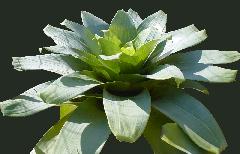
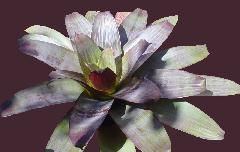
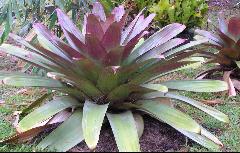
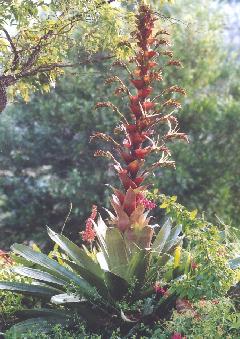
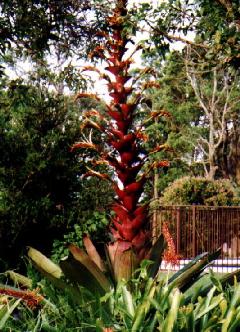
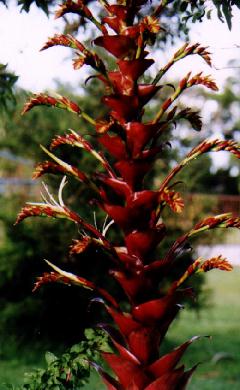
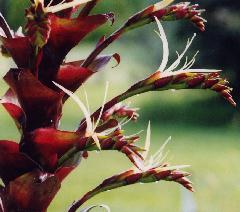
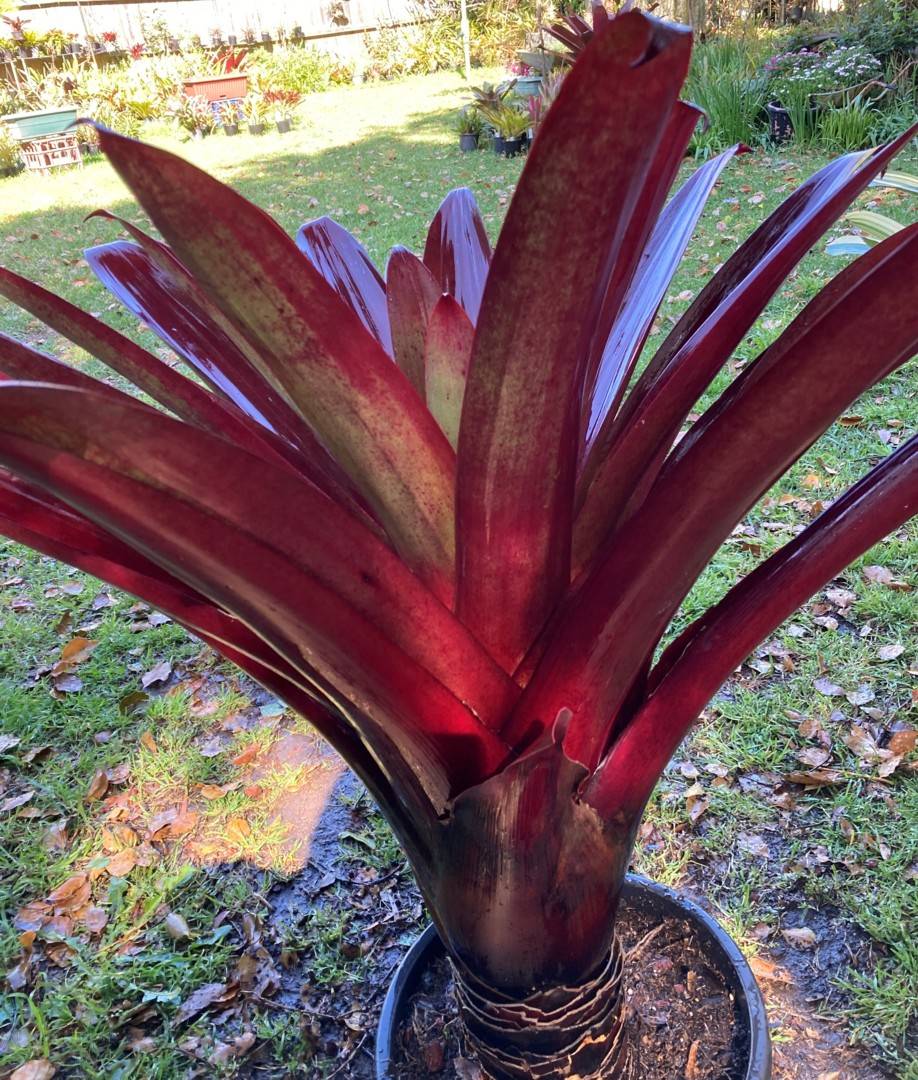
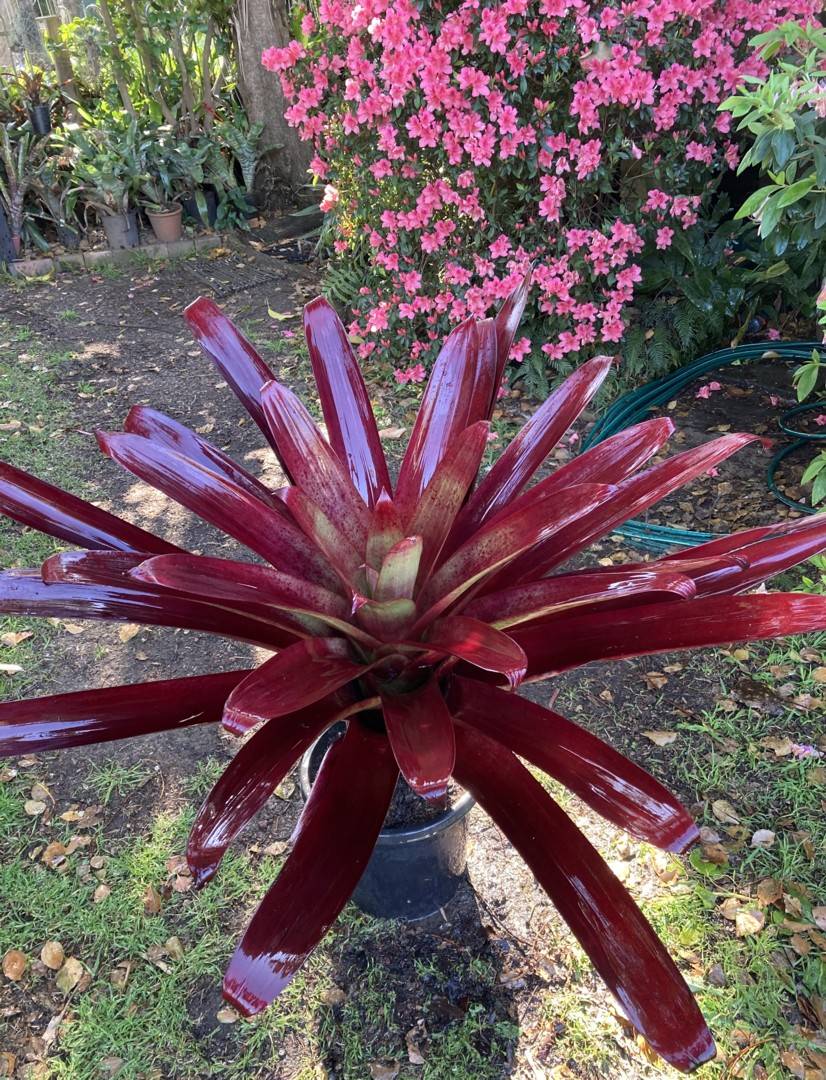
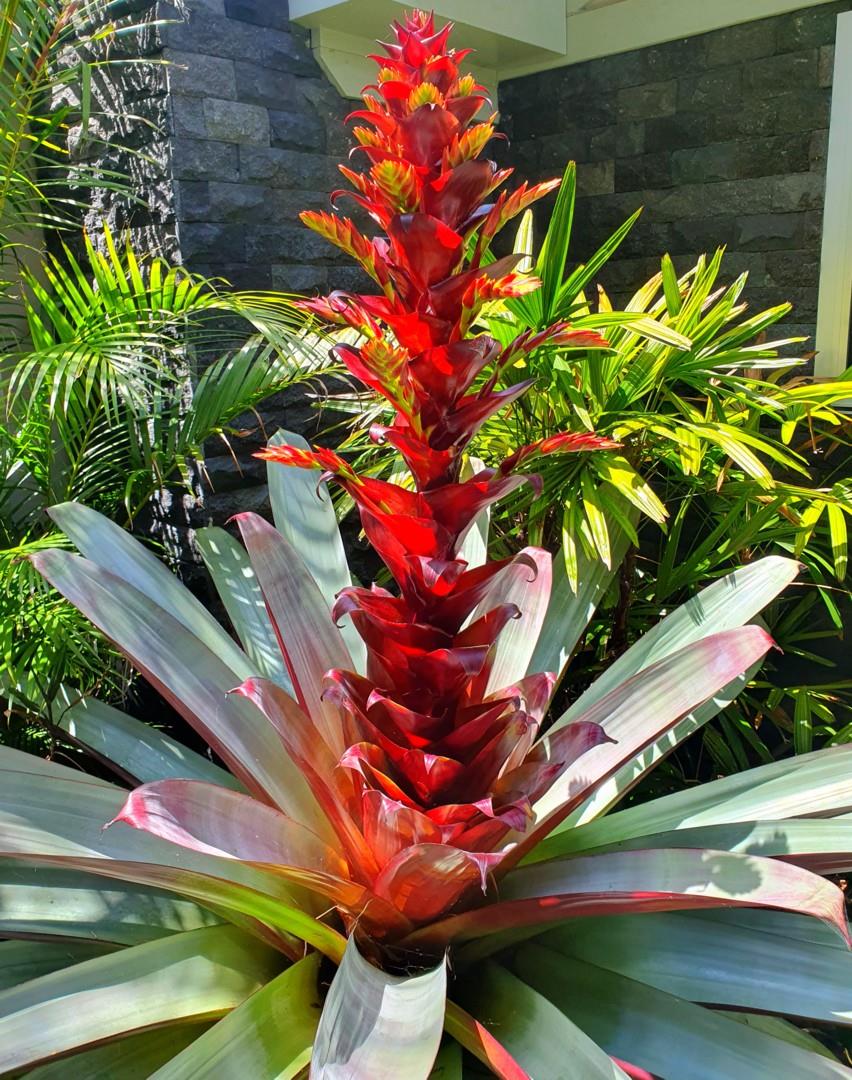
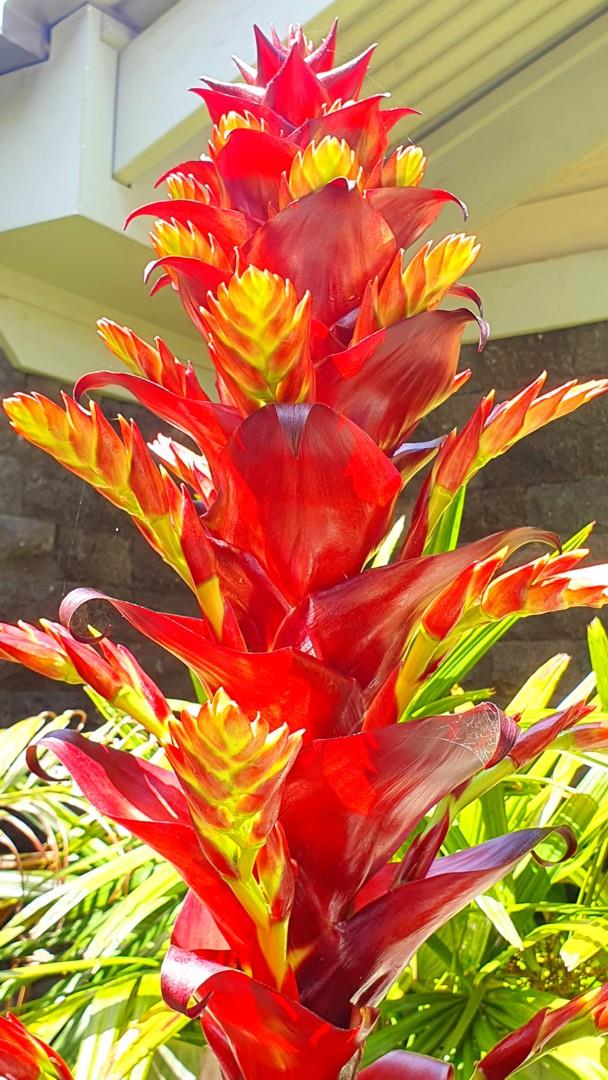
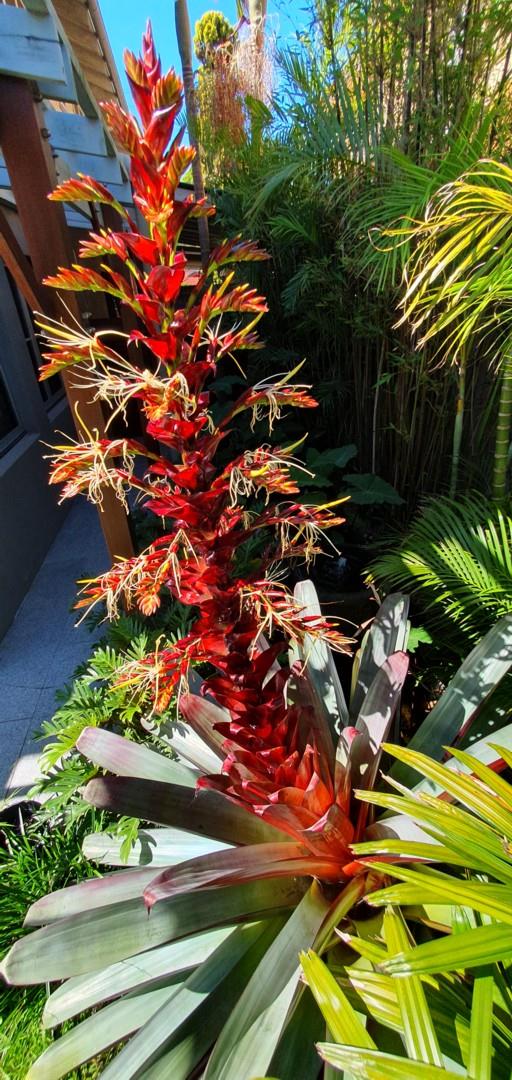
Let us get rid of the term 'rubra' used with Alcantarea imperialis or at least try. Nobody has defined this quasi-botanical term by writing a description under the ICN rules as a botanist would do. It is not acceptable under the ICNCP rules for a cultivar either.
The following is what Versieux and Wanderley published in ‘Bromelias Gigantes do Brasil’, 2015, which is a very definitive book on the genus Alcantarea: “There is considerable morphological intraspecific variation in the different popu-lations studied, particularly with regard to the colour of the central rosette leaves and peduncle bracts. In the populations of Macae de Cima, in Nova Friburgo, Rio de Janeiro, Brazil, it is possible to observe individuals totally green growing alongside those totally vinous (Barbara et al. 2007). For gardeners, such varia-tions constitutes important sources of selection of cultivars, which can be totally green plants, completely red-vinous with variations between the lighter shades or dark, or plants with leaves almost completely green, only with the tips vinous and peduncle bracts vinous at the base, passing to green concolor”.
Nobody has defined what 'rubra' refers to: Is it the red leaves or red peduncle/primary bracts or must it have both ? Does a tinge of red in the leaves qualify ?
The use of the word 'rubra' in this context should be banned from Bromeliad Newsletters. Regrettably some growers will always use the word on their labels even though it has no botanical validity in conjunction with the botanically described, Latinised words Alcantarea imperialis.
After some discussion it has been agreed that there is no way a single cultivar name could be used for this ill-defined red form of Alc. imperialis.
The redness is quite normal however variable the plants may be. Remember the term ’rubra’ is only a descriptive trade or nursery name. The use of such terms should be banned. If you must use a descriptor use “red form”.
If sellers are serious about their use of the name ‘Rubra’ they should select their distinctive forms and think of alternative names and register them as Cultivars.
For similar reasons “Purpurea” should be banned too.
Acknowledgements: Peter Franklin, Geoff Lawn and Derek Butcher.
Basionym: Vriesea imperialis Carriere, Rev. Hort 60: 58. 1888.
Synonyms:
Vriesea glaziouana sensu Carriere, Rev. Hort 53: 50, fig. 15. 1881; as "glazioveana"; non Lemaire, 1867.
Vriesea hillegeeriana hortus ex Antoine, Phyto-Iconogr: Bromel. 15. 1884; nomen.
Vriesea blokii Hort., Card, Chron. 3. 23: 254. 1898; as "bloki"; nomen.
Tillandsia blokii Hemsley, Bot Mag. 134: pl. 8192. 1908. Tipo/Type: F. W Moore s. n., fl. cult. 1908 (K).
Vriesea blokii hortus ex Hemsley, Bot. Mag. 134: pl. 8192.1908; nomen.
Vriesea blokii (Hemsley) Mez, in Engler Pflanzenr: IV 32: 405. 1935.
TYPE: Brasil, Hortus Paris Museum .s n. Holotype: P, n. v.
The study of the genus Alcantarea necessarily included taxons that are today placed in synonymy. One of these is Vriesea blokii, considered by Smith & Downs (1977) to be a synonym of Alcantarea regina.
Tillandsia blokii was described in 1908 by W. Botting Hemsley who, at the time, was working on the identity of the various species that had up to then been cited in the literature as V. regina. According to this author, the identification of these species had been based on a primitive drawing from Vellozo's Flora Fluminensis of 1831 (effective publication date of this work; Leme, unpub. manuscript).
According to Hemsley, the historical origin of T. blokii is obscure. The first specimen of this taxon appeared at an exhibit in Ghent, Belgium, in 1898, and it was mentioned that same year in The Gardener's Chronicle (23: 254): "The giant of the family was a huge specimen of Tillandsia (Vriesea) regina, shown as V. bloki, It was as tall as a man, and was in flower. This same author reported that he had obtained T. blokii from F. W. Moore. Moore's original letters to Hemsley are part of the holotype of T. blokii, and here we learn that the specimen was purchased for 25 francs in I'Horticulture Colonial, Brussels, Belgium, in April 1903. It went by the name Vriesea blokii and had originated from seed of the specimen shown at Ghent.
Mez (1935) officially transferred T. blokii to the genus Vriesea, considering it a valid species of the subgenus Alcantarea. Based on historical references available at the time, Smith, (1955) regarded the taxon as a synonym of V. regina, a position he maintained in his revision of the genus Vriesea (1966) and in Smith & Downs ( 1977). Grant ( 1995) revalidated the genus Alcantarea but did not examine in depth the synonyms of the included species.
Hemsley did not have a complete flowering specimen of the plant at his disposal. He examined only a primary bract, a flowering branch and a leaf sent by Moore who, on February 17, 1908, also sent a photograph of the specimen in the post-flowering stage, plus a primary bract and a branch with capsules and seeds. Except for the photograph of the plant's habit, this material constitutes the four herbarium sheets of the holotype of Vriesea blokii deposited in the herbarium of the Royal Botanic Gardens at Kew, England.
A close examination of the holotype revealed that certain traits of V. blokii do not coincide with the concept of Alcantarea regina. As a matter of fact, this species is fully compatible with A. imperialis and I propose that it be synonymized with this species.
Hemsley stated categorically in the protologue that A. imperialis is distinguished from the other species by its unilaterally distichous flowers and white petals. He did not realize, however, that his species T. blokii also had unilaterally distichous flowers, as can be seen in the holotype; this is clearly visible in the herbarium sheet that contains the post-flowering-stage branch. Interestingly enough, the branch with preserved petals, also part of the holotype, which is depicted in color in plate 8192 (part of the protologue) does not have this trait. This is because of the way it was mounted (it was probably pressed in a frontal position), thus masking the unilateral arrangement of the flowers. The keels of the floral bracts lent credence to this assumption because they are positioned off-center on the herbarium sheet, as if they were asymmetrical, thus revealing a non-divergent original position, different from that in which they were preserved. The colors on the original plate of V. blokii (bracts and sepals inordinately red and petals intensely yellow) are apparently the result of an attempt to reproduce the true color pattern of the species because branch coloring was probably already faded, if in fact it was preserved, when Hemsley received this material from Moore. Even the withered petals mistakenly have the same intense yellow color as the fresher petals, and these do not show the recurved-spreading movement typical in Alcantarea. Furthermore, before anthesis the petals of A. imperialis are yellowish in the daytime, turning white as the flowers open fully at night.
Desc from S&D
248. Vriesea imperialis Carriere, Revue Hort. 60: 58. 1888. Fig 425 A-F.
Vriesea gigantea Lemaire, III. Hort. 14: sub pl. 516. 1867; as to description, not as to plate, nor Gaudichaud, 1843; also as to Misc.: 43, fig. 1.
Vriesea glaziouiana sensu Carriere, Revue Hort. 53: 50, fig.15, pl.1881; non Lemaire, 1867.
Vriesea hillegeeriana hortus ex Antoine, 15. 1884; nomen.
Tillandsia regina sensu Baker, Handb. Bromel. 227. 1889; in part, non Vellozo, 1825.
Alcantarea imperialis (Carriere) Harms in Engler & Prantl. Nat. Pflanzenfam. ed. 2. 15a: 126. 1930.
Plant flowering 3-5 m high; stem erect, stout.
Leaves many in a funnelform rosette, to 15 dm long;
Sheaths very broadly elliptic, 25 cm wide, densely and minutely darklepidote;
Blades ligulate, acute or acuminate, 12 cm wide, wholly green or obscurely maculate toward base, glabrous above, minutely lepidote beneath.
Scape erect, exceeding the leaves, ca 45 mm in diameter;
Scape-bracts suberect, densely imbricate, recurved toward apex.
Inflorescence laxly bipinnate, slenderly pyramidal; primary bracts broadly ovate with a small narrow blade, about equaling the sterile bases of the branches;
Branches densely 10-50-flowered, suberect at the sterile base with 3-4 bracts, then spreading and decurved; rhachis more or less geniculate, the internodes 2-4 cm long.
Floral bracts secund with the flowers, ovate, acute, about half as long as the sepals, carinate, incurved; flowers spreading, upwardly secund;
Pedicels obconic, stout, 1 cm long.
Sepals elliptic, ca 4 cm long, 15 mm wide, ecarinate;
Petals over 10 cm long, linear, obtuse, white, bearing 2 large linear scales at base, flaccid and pendent at anthesis.
Capsule slenderly ovoid, long-beaked, 55 mm long; seeds with coma at both ends.
Type. Hortus Paris Museum s n (holotype P (?), n v, doubtfully preserved), Brazil.
DISTRIBUTION. Saxicolous on high cliffs, 1300 m alt, Rio de Janeiro State, Brazil. BRAZIL. RIO DE JANEIRO: Serra dos Orgaos, Glaziou 13262 (US); Pedra do Conico, Nova Friburgo;Jan 1898, Ule 4655 (CORD, HBG); Parque Nacional, Teresopolis, 3 Feb 1952, L. B. Smith & Brade 5653 (US).
From Mez in Das Pflanzenreich 1935
112. V. Blokii (Hort. ex Bot. Mag. 4. ser. IV. [1908] t. 8192) Mez comb. nov. –
Tillandsia Blokii (Hort. ex Gard. Chron. 1898, 254 et ex Journ. Hort. Fr. 1898, 479, nomen) Hemsl. in Bot. Mag. 1. c. –
Bimetralis. Folia crassa, coriacea, lineari-oblonga, usque ad 1m longa, infra medium ad 0,15 m lata, apice abrupte longeque acuminata, recurva, maculis rubro-purpureis ornata. Inflorescentia amplissime panniculata, ad 1,5 m longa; scapo vaginis amplis, coriaceis, sanguineis, ovato-acuminatis, diu persistentibus vestito; ramis recurvis, 20-30 cm longis, flexuosis, sanguineis, usque ad 12-floris; bracteis florigeris ovatis, acutis, quam sepala duplo brevioribus. Flores haud secundi, ad 0,1 m longi; sepalis lanceolatis, 40-50 mm longis, acutis, sanguineis, coriaceis. Petala ad 0,1 m longa, biligulata, lutea, fasciata. Seminum coma ferruginea.
Heimat unbekannt, wahrscheinlich Ost - Brasilien. - Ich habe die Art von den Kew-Gardens erhalten ; sie hat bei mir noch nicht gebluht.
Plant flowering to 2 metres.
Leaves thick, coriaceous, linear oblong, up to 1m long, below the middle to 0,15 m wide, tip abrupt long acuminate, recurved, with reddish purple spots.
Inflorescence very amply paniculate, to 1,5 m long;
Scape bracts sheaths ample, leathery, reddish, ovate acuminate, persistent for a long time;
Branches recurved, 20-30 cm long, flexuous, reddish, up to 12-flowered;
Floral bracts ovate, acute, twice as short as the sepals.
Flowers not at all secund, ad 0,1 m long;
Sepals lanceolate, 40-50 mm long, acute, reddish, coriaceous.
Petals to 0,1 m long, with two ligules, yellow, banded.
Seed with brownish coma.
Habitat unknown, probably east Brazil. – I obtained the type from Kew Gardens but it has not yet flowered for me.
Observations carried out on the inland slopes of this mountain range have shown that around 80-90% of the rupicolous plant communities have changed drastically in physiognomy, plant frequency and dispersal and population turnover processes. The huge wild fire that swept the Maria Comprida mountains in late 1994, for example, destroyed practically all of the vegetation, leaving only a few insignificant remnants of primary forest. The main propagating agent of fire on these slopes is molasses grass (Melinis minutiflora), an exotic species that thrives in the climate and soils of the Petropolis region.
Seeds of M. minutiflora germinate rapidly during the rainy season, producing abundant plant biomass (up to lm tall). The vegetative cycle ends at the onset of winter, with the production of copious amounts of viable seed. The harsh dry season that invariably castigates the region from June to September brings a rash of fires that swiftly consume the plentiful fuel and cut short the dormant period of this grass, thus speeding up the pernicious cycle.
During the rainy season, the microclimate formed by the large amount of molasses grass biomass favors attack by fungi and bacteria on the bromeliads which are literally immersed in the thick grass, and also reduces the incident light essential for growth. These cyclic grass fires destroy huge numbers of adult plants as well as practically all the seedlings, thus interrupting the difficult process of population turnover.
We have reason to believe that the association fire-molasses-grass may bring about the imminent extinction of the royal bromeliad in the Petropolis area within the next 40 years. This is time enough for most living adult plants to complete their life cycle and die, leaving no descendents. We also believe that Mellinis alone is not capable of creating such a formidable barrier for these rupicolous plant communities but it maintains a dominant role because of its association with cyclic fires. Two important things should be done to avoid the imminent extinction of A. imperialis: large scale production of the species to satisfy the landscape design market, and organized fire prevention in the montane region of Petropolis.